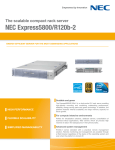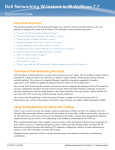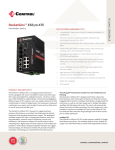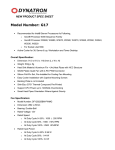Download Dell PowerConnect W-Airwave 7.4 Sizing Guide
Transcript
Dell PowerConnect WAirWave 7.4 Server Sizing Guide Copyright © 2011 Aruba Networks, Inc. Aruba Networks trademarks include , Aruba Networks®, Aruba Wireless Networks®, the registered Aruba the Mobile Edge Company logo, and Aruba Mobility Management System®. Dell™, the DELL™ logo, and PowerConnect™ are trademarks of Dell Inc. All rights reserved. Specifications in this manual are subject to change without notice. Originated in the USA. All other trademarks are the property of their respective owners. Open Source Code Certain Aruba products include Open Source software code developed by third parties, including software code subject to the GNU General Public License (GPL), GNU Lesser General Public License (LGPL), or other Open Source Licenses. The Open Source code used can be found at this site: http://www.arubanetworks.com/open_source Legal Notice The use of Aruba Networks, Inc. switching platforms and software, by all individuals or corporations, to terminate other vendors’ VPN client devices constitutes complete acceptance of liability by that individual or corporation for this action and indemnifies, in full, Aruba Networks, Inc. from any and all legal actions that might be taken against it with respect to infringement of copyright on behalf of those vendors. Dell PowerConnect W-AirWave 7.4 | Server Sizing Guide 0510830-03 | December 2011 Contents Preface....................................................................................................................................................................... 5 Document Organization..................................................................................................................... 5 Note, Caution, and Warning Icons .................................................................................................. 5 Contacting Support ............................................................................................................................ 6 Chapter 1 Selecting Your Hardware Components ........................................................................... 7 CPU, Memory, and Storage Matrix.................................................................................................. 7 Choosing Your CPU ............................................................................................................................ 8 Choosing Your Memory ..................................................................................................................... 9 Choosing Your RAID Controller ........................................................................................................ 9 RAID Configuration Information............................................................................................... 9 200 Devices and Below ..................................................................................................... 9 500 Devices ......................................................................................................................... 9 1,000 Devices ...................................................................................................................... 9 1,750 Devices ...................................................................................................................... 9 2,500 Devices ...................................................................................................................... 9 5,000 Devices - Non-SSD Drives...................................................................................... 9 5,000 Devices - SSD Drives............................................................................................. 10 Choosing Your Hard Drives............................................................................................................. 10 SSDs vs 15K SAS ...................................................................................................................... 10 Chapter 2 Configuring Your Hardware ............................................................................................. 11 CPU Configuration ............................................................................................................................ 11 Disk Partitioning................................................................................................................................ 11 Filesystem Configuration................................................................................................................. 11 Chapter 3 Virtualization and Scalability ........................................................................................... 13 Virtualization...................................................................................................................................... 13 Scalability Assumptions .................................................................................................................. 13 Appendix A Sizing a Master Console And Failover ........................................................................... 15 Master Console................................................................................................................................. 15 Failover Server.................................................................................................................................. 15 Dell PowerConnect W-AirWave | Server Sizing Guide | 3 4 | Dell PowerConnect W-AirWave | Server Sizing Guide Preface This preface provides an overview of this guide, a list of all documentation available for AirWave 7.4, including contact information for Dell, and includes the following sections: “Document Organization” on page 5 “Note, Caution, and Warning Icons” on page 5 “Contacting Support” on page 6 Document Organization This document provides guidelines for purchasing new hardware which hosts AirWave. NOTE: Dell PowerConnect W-Series AirWave Wireless Management Suite (AWMS), AirWave, and AirWave Management Platform (AMP) refer to the same product set and are used interchangeably. Table 1 Document Organization and Purposes Chapter Description Chapter 1, “Selecting Your Hardware Components” on page 7 Provides an overview of the sizing information. Chapter 2, “Configuring Your Hardware” on page 11 Details information about the CPU, Disk, and file system configuration of AirWave. Chapter 3, “Virtualization and Scalability” on page 13 Discusses virtual machines and scaling of AirWave. Appendix A, “Sizing a Master Console And Failover” on page 15 Includes specifications for Master Console and Failover. Note, Caution, and Warning Icons This document uses the following note, caution, and warning icons to emphasize advisories for certain actions, configurations, or concepts: NOTE: Indicates helpful suggestions, pertinent information, and important things to remember. CAUTION: Indicates a risk of damage to your hardware or loss of data. WARNING: Indicates a risk of personal injury or death. Dell PowerConnect W-AirWave 7.4 | Server Sizing Guide Preface | 5 Contacting Support Table 2 Web Support Web Support 6 | Preface Main Website dell.com Support Website support.dell.com Documentation Website support.dell.com/manuals Dell PowerConnect W-AirWave 7.4 | Server Sizing Guide Chapter 1 Selecting Your Hardware Components This overview chapter includes the following topics: “CPU, Memory, and Storage Matrix” on page 7 “Choosing Your CPU” on page 8 “Choosing Your Memory” on page 9 “Choosing Your RAID Controller” on page 9 “Choosing Your Hard Drives” on page 10 CPU, Memory, and Storage Matrix The following table lists the recommended specifications for optimum Dell PowerConnect W-AirWave server performance. Table 3 Recommended CPU, Memory, and Storage Managed CPU Class Devices Min. Clock AirWave Speed CPUs Memory (GHz) Sustained AirWave IOPs Storage Performance 4KB random write Min. Disk Configuration Pilot 1-25 APs Single Quad Core Intel® Xeon I3-2100 3.1 1 8 GB 75 GB 30 (1) 15K SAS 100 Single Quad Core Intel® Xeon E3-1220 3.1 1 8 GB 75 GB 60 (1) 15K SAS 200 Single Quad Core Intel® Xeon E3-1240 3.3 1 8 GB 75 GB 120 (1) 15K SAS 500 Single Quad Core Intel® Xeon W3670 3.2 1 12 GB 75 GB 300 (4) 15K SAS in RAID 1+0 1,000 Single Quad Core Intel® Xeon X5687 3.6 1 16 GB 187 GB 600 (6) 15K SAS in RAID 1+0 1,750 Single Quad Core Intel® Xeon X5687 3.6 1 24 GB 275 GB 1,000 (8) 15K SAS in RAID 1+0 2,500 Dual Quad Core Intel® Xeon X5687 3.6 2 32 GB (36 GB optimized**) 375 GB 1,500 (8) 15K SAS in RAID 1+0 5,000 Dual Hex Core Intel® Xeon X5690 3.46 2 64 GB (72 GB optimized**) 600 GB 3,000 (16) 15K SAS in RAID 1+0 ** Optimized memory can vary depending on the vendor configuration. For more information, contact Dell support at support.dell.com. NOTE: Ensure that the disk subsystem can sustain these 4KB random write rates. Sustained sequential write rates will not help because Dell PowerConnect W-AirWave writes are primarily random. Dell PowerConnect W-AirWave 7.4 | Server Sizing Guide Selecting Your Hardware Components | 7 The following table lists the minimum specifications required to run AirWave. Table 4 Minimum CPU, Memory, and Storage Managed CPU Class Devices Min. Clock Speed (GHz) Sustained Min. Disk AirWave AirWave IOPs ConfiguraCPUs Memory Storage Performance tion 4KB random write Pilot 1-25 APs Single Quad Core Intel® Xeon I3-2100 3.1 1 4 GB 75 GB 30 (1) 15K SAS 100 Single Quad Core Intel® Xeon E3-1220 3.1 1 6 GB 75 GB 60 (1) 15K SAS 200 Single Quad Core Intel® Xeon E3-1240 3.3 1 6 GB 75 GB 120 (1) 15K SAS 500 Single Quad Core Intel® Xeon W3670 3.2 1 8 GB 75 GB 300 (4) 15K SAS in RAID 1+0 1,000 Single Quad Core Intel® Xeon X5687 3.6 1 12 GB 150 GB 600 (4) 15K SAS in RAID 1+0 1,750 Single Quad Core Intel® Xeon X5687 3.6 1 18 GB 225 GB 1,000 (6) 15K SAS in RAID 1+0 2,500 Dual Quad Core Intel® Xeon X5687 3.6 2 24 GB 300 GB 1,500 (6) 15K SAS in RAID 1+0 5,000 Dual Hex Core Intel® Xeon X5690 3.46 2 48 GB 450 GB 3,000 (16) 15K SAS in RAID 1+0 Dell PowerConnect W-AirWave includes the 64-bit CentOS operating system based on Red Hat Enterprise Linux (RHEL) and is installed by default. NOTE: If you choose to install RHEL instead of the supplied CentOS, you will need to purchase your own RHEL license and support separately. Your hardware should incorporate margin for WLAN expansion as well as future AirWave features and modules. These recommended specifications are formulated to keep AirWave running on the same hardware platform for up to three years. Factors which influence the processing requirements for your AirWave server: How many devices will the server manage? How often will AMP communicate with these devices? NOTE: To ensure hardware capability, purchase server hardware that is certified to be compatible with Red Hat Enterprise Linux 5 (RHEL5). Choosing Your CPU For most Dell PowerConnect W-AirWave installations, select high-performance Xeon X or W-series based CPUs. Scalability testing uses Intel based hardware at this time. See Table 3 for recommendations on CPU selection based on clock speed and core type. 8 | Selecting Your Hardware Components Dell PowerConnect W-AirWave 7.4 | Server Sizing Guide Choosing Your Memory Dell PowerConnect W-AirWave's memory recommendations scale linearly with the managed device count. With AirWave servers running at full load for those device counts with a large number of floorplans, the recommended memory usually results in best overall performance. Best performance is defined by minimal disk reads due to sufficient caching, thus allowing for maximum disk write performance and minimal CPU I/O wait time. Choosing Your RAID Controller RAID 1+0 is the ONLY supported RAID configuration for AirWave. NOTE: Software RAID and SATA drives are NOT SUPPORTED for any configuration of AirWave. RAID Configuration Information For RAID 1+0: Dedicated Hardware RAID controller with caching and battery backup or non volatile (NV) cache. RAID controller should be configured for Write-Back caching with battery backup (unless NVcache is selected, then Force Write-Back without Battery backup is recommended). Individual Drive Caching should be enabled. Ensure that all disks are assigned and configured to a single volume. CAUTION: Improper RAID configuration can result in drastically reduced server performance. 200 Devices and Below AirWave 100 and 200 models perform well on a single, fast (spindle speed) disk. 500 Devices RAID 1+0 configuration of four (4) or more 15K SAS drives in a single volume with dedicated Hardware RAID controller with minimum 256MB of cache and battery backup. 1,000 Devices RAID 1+0 configuration of four (4) or more 15K SAS drives in a single volume with dedicated Hardware RAID controller with minimum 256MB of cache and battery backup. 1,750 Devices RAID 1+0 configuration of six to eight (6-8) or more 15K SAS drives in a single volume with dedicated Hardware RAID controller with minimum 512MB of cache and battery backup. 2,500 Devices RAID 1+0 configuration of six to eight (6-8) or more 15K SAS drives in a single volume with dedicated Hardware RAID controller with minimum 1GB of cache and battery backup. 5,000 Devices - Non-SSD Drives RAID 1+0 configuration of sixteen (16) or more 15K SAS drives in a single volume with dedicated Hardware RAID controller with minimum 1GB of cache and battery backup. Dell PowerConnect W-AirWave 7.4 | Server Sizing Guide Selecting Your Hardware Components | 9 5,000 Devices - SSD Drives AWMS 2,500 - 5,000 device installations with SSDs require Single Level Cell (SLC) Enterprise class SSD drives. CAUTION: Do not use Multi Level Cell (MLC) Consumer class drives. Use of MLC drives can result in drastically reduced SSD drive lifespan and data loss/volume failure due to write exhaustion. A minimum of six (6) Enterprise SSDs in a RAID 1+0 configuration are required (Please see “CPU, Memory, and Storage Matrix” on page 7 for minimum needed storage capacity information). Eight (8) or more SSDs in a RAID 1+0 configuration are recommended. The target random write 4KB IOP Performance is at minimum 3,000 sustained IOPS for 5,000 device monitoring. The actual disk IOP requirement can vary depending on the configuration of the AirWave server. NOTE: If you have any questions regarding hardware compatibility or selection, contact Dell support at support.dell.com. NOTE: AirWave servers servicing more than 2,500 devices require 64-bit OS and AirWave 7.1 or higher. Do not use software RAID systems or SATA disk drives. Choosing Your Hard Drives 15K SAS drives are the highest performance spinning platter drives available today. Serial ATA and 10K SAS are vastly outperformed by 15K SAS and should not be used in an AirWave server. You will need to select the appropriately sized hard drive to meet your desired storage volume after taking into account RAID 1+0 reduction on overall storage capacity. RAID 1+0 reduces your single volume available drive space by ½ because of the redundancy introduced.An example would be 16x 146GB 15K SAS hard drives in a RAID 1+0 volume will result in approximately 1.1 TB of storage space [(16*146GB)/ 2] SSDs vs 15K SAS Solid State Drives are becoming more affordable and are being offered as a high performance drive option by many vendors. SSDs offer performance that far outstrips 15K SAS, but at a significant cost premium. Dell PowerConnect W-AirWave supports deployment on SSD based storage arrays and can take advantage of the high speed disk access and stellar random write performance. To select an appropriate SSD you'll want to ensure that the SSD is classified as "Enterprise" class. This generally indicates a drive that uses Single Level Cell (SLC) technology versus Multi Level Cell (MLC) technology. SLC technology is required for an AirWave server to avoid unexpected write exhaustion and/or poor performance due to write amplification. Confirm with your vendor prior to purchasing SSDs that their offerings are appropriate for a 24/7 sustained high random write database server and are not a consumer-grade SSD. In general, RAID 1+0 is still recommended for SSD deployments to allow for the best overall redudancy and performance. Any parity based RAID (5/6/etc) is not recommended. For additional information, please contact Dell support at support.dell.com. 10 | Selecting Your Hardware Components Dell PowerConnect W-AirWave 7.4 | Server Sizing Guide Chapter 2 Configuring Your Hardware This chapter explains sizing information for the following topics: “CPU Configuration” on page 11 “Disk Partitioning” on page 11 “Filesystem Configuration” on page 11 CPU Configuration Ensure that Power Management is configured for Maximum Performance. By default, most vendors configure BIOS to an eco-friendly setting. Ensure that Memory Operating Mode is configured to Optimizer Mode, if available. Disk Partitioning Dell PowerConnect W-AirWave 7.4 automatically partitions the disk subsystem upon installation. You can override these values. Table 5 below lists the default partitioning and provides guidance for more advanced scenarios. Table 5 Default Partitions Default Partitions Size boot 100 MB swap 4 GB / Remainder of disk space Filesystem Configuration For Dell PowerConnect W-AirWave 7.4, the NOOP File I/O scheduler provides the best random write performance. If you are running Airwave 7.2 or newer, Airwave should automatically manage this setting for you. To check the currently assigned scheduler (if sda is not your device name, please replace with the correct device name): # cat /sys/block/sda/queue/scheduler noop anticipatory deadline [cfq] (Sample Output) To configure noop as your preferred scheduler: # echo noop > /sys/block/sda/queue/scheduler And confirm that your change has been applied: # cat /sys/block/sda/queue/scheduler [noop] anticipatory deadline cfq (Expected Output) Dell PowerConnect W-AirWave 7.4 | Server Sizing Guide Configuring Your Hardware | 11 12 | Configuring Your Hardware Dell PowerConnect W-AirWave 7.4 | Server Sizing Guide Chapter 3 Virtualization and Scalability This chapter includes the following topics: “Virtualization” on page 13 “Scalability Assumptions” on page 13 Virtualization Dell PowerConnect W-AirWave can run in a VMWare and Xen virtualized environment. To ensure scalability, dedicate the processing and memory. You must also ensure that the disk subsystem can maintain the IOPS throughput as detailed below. Most virtualized environments use a shared disk subsystem assuming that each application will have bursts of I/O without a sustained high I/O throughput. AirWave requires a continuous sustained high data I/O rate. For virtualized environment, use dedicated hardware. If you are using the specifications outlined in Table 3, the hardware for virtualization should exceed these specifications by 20%. NOTE: A 20% increase buffer is recommended for virtualized environments. Ensure you allocate enough extra disk space for the OS and swap when partitioning the virtual disk. Scalability Assumptions Using the specs outlined in Table 3, scalability tests are based on the following assumptions. Deviations from these assumptions can impact overall scalability of your AirWave server. Table 6 Wireless Scalability Test Values Category Value Average density of client devices per access point 5 Device configuration auditing interval Daily Up/Down status polling period (minutes) 5 User data polling period (minutes) 10 Thin AP discovery period (minutes) 15 Device-to-device link polling period (minutes) 20 Device bandwidth polling period (minutes) 10 802.11 counters polling period (minutes) 15 Rogue AP and device location data polling period (minutes) 30 CDP neighbor data polling period (minutes) 60 NOTE: Auditing more than once a day can have a tremendous impact on scalability. Dell PowerConnect W-AirWave 7.4 | Server Sizing Guide Virtualization and Scalability | 13 Table 7 Wired Scalability Test Values Category Value Ratio of switches/routers to access points 20% Average port density of switches/routers 36 Read ARP polling period (hours) 8 Read CDP table for device discovery polling period (hours) 8 Read bridge forwarding table polling period (hours) 8 Interface polling period (minutes) 20 Table 8 VisualRF Scalability Test Values Category Value Average floor plan size (feet) 62,500 Number of access points per floor plan 20 Number of clients per floor plan 100 Number of attenuation grid cells per floor plan 2,500 Number Rogue devices per floor plan 20 AMP Synchronization timer (minutes) 15 Rogue location timer (minutes) 30 Location calculation timer (min/max/number of samples) 90/360/3 14 | Virtualization and Scalability Dell PowerConnect W-AirWave 7.4 | Server Sizing Guide Appendix A Sizing a Master Console and Failover Master Console Table 9 Master Console Specifications Clock Speed (GHz) CPUs Total Cores Memory Disk Subsystem Quad Core Intel® Xeon® X5687 3.6 1 4 12 GB (4) 73GB, 15K RPM - RAID 1+0, 146 GB of usable disk space Quad Core Intel® Xeon® X5687 3.6 2 8 24 GB (6) 146GB, 15K RPM - RAID 1+0, 438 GB of usable disk space Environment Size CPU Class Small (2-3 servers) Large (>3 servers) Failover Server The Failover server should be as powerful as the most powerful AMP server that it is monitoring to ensure smooth operation in a failover situation. Dell PowerConnect W-AirWave 7.4 | Server Sizing Guide Sizing a Master Console and Failover | 15 16 | Sizing a Master Console and Failover Dell PowerConnect W-AirWave 7.4 | Server Sizing Guide
















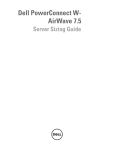

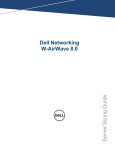
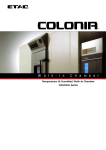
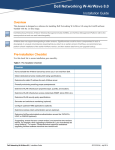
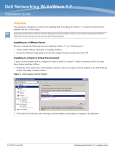
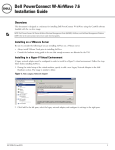
![Manual condicionador de sinal SD20 [PTBR]](http://vs1.manualzilla.com/store/data/006085115_1-891da68fb4d8bbd4bc5f0d8350060514-150x150.png)
